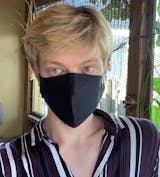Silk has been found to have hypoallergenic properties, which is what makes Fait avec Coeur’s pure silk face masks, eye masks and pillowcases so great for allergy-sufferers. So what are the hypoallergenic properties of silk? Why should you use silk for allergies? And what are some other ways to make your house an allergen-free, safe space.
Why Consider Silk for Allergies? The Hypoallergenic Properties of Silk
Allergies are unpleasant, to say the least. They can cause itchiness, rashes, breakouts, redness, swelling, and other problematic side effects. If you are allergy prone, it can be difficult to navigate your way through life while trying to avoid materials that trigger your allergies.
So, you already know it’s a good idea to embrace hypoallergenic materials when you can. If you are allergic to common textiles or find them irritating because of sensitive skin, using silk for allergies will make your life a lot easier.
The term hypoallergenic literally translates to ‘slightly allergenic, and means that something is relatively unlikely to cause an allergic reaction. No, we’re not talking about materials that cure allergies or remove allergens – it just refers to substances that probably won’t aggravate your existing allergies.
Research has shown that certain compounds within silk actually stimulate the immune system to produce more of the compounds responsible for limiting your body’s response to allergens. (Interleukin 10 or IL-10)
This means that if you are allergic to certain textiles or have sensitive skin, wearing silk would be a good idea for you. It isn’t likely to trigger any allergies, which is why our silk facemasks and bedsheets make an excellent addition to your daily life.
Silk is also resistant to collecting dust mites, a huge culprit for allergy sufferers. The reason is quite interesting, too! You see, the silk cocoon is made up of the protein called sericin. Sericin acts as a natural, organic sort of pesticide to protect the silkworm inside from predators such as dust mites. So, think of your silk sheets as a protective chrysalis of your very own, keeping allergy-inducing dust mites at bay.
Additionally, pure silk fibers are more resistant to the growth of mildew than plant fibers, like cotton. Between mildew resistance and the fact that silk doesn’t absorb as much moisture as traditional materials, silk bedsheets and pillowcases are a great choice for people whose allergies are triggered by the slightest presence of mildew.
And finally, pure organic silk is smooth and soft, which makes it perfect for sensitive skin, reducing skin irritation that occurs while sleeping or wearing a face mask daily.
Tips for Reducing Allergens Around your Home
How about some other tips for reducing allergens in your home? There are many types of allergies and symptoms that go along with allergic reactions. For example, contact dermatitis occurs when your skin comes in contact with an allergen and becomes red, inflamed, and irritated. Or asthma, which can be triggered by inhaling allergens.
Let’s explore ways to remove allergens that trigger various types of allergic responses.
- Vacuum your home weekly
Many people are allergic to dust mites, and vacuuming once or twice a week will help control dust mites. Consider bare (uncarpeted) floors in your bedroom and living room, since that’s where you spend the most time. Carpet accumulates dirt and dust, and vacuuming often stirs up dust in the process of removing what’s trapped in the floor. And for those who hate putting their bare feet on cold floors first thing in the morning, we even have washable carpet options these days!
- Pets are a no-no
If you’re allergic to pet dander, unfortunately most pets aren’t an option for you. You can keep pets such as lizards and fish, but any animal with fur or feathers will likely trigger your allergies due to the high volume of dander that are shed daily from pets. If you already have pets, keep them out of your bedroom. When you go out, shut the bedroom door to keep them out. Bathing your pets often (if possible) will also reduce dander.
- Prevent pollen from getting inside
Another common allergen is pollen, and during spring and summer it’s at an all-time high. Prevent an allergic reaction by keeping your windows shut. When traveling, keep your car windows up, and wear a facemask if necessary, so you don’t breathe in pollen.
- Get silk pillow covers and bedsheets
When using silk for allergies, consider the main benefit in your bedroom, which should be the one place where you can be free from allergens and irritants. Silk pillow covers and bed sheets won’t irritate your skin and cause rashes.
- Use gentle cleaning products
Harsh chemicals found in artificial cleaning agents can trigger allergies or cause an asthma attack. So, switch to green cleaning products. Not only are they good for the environment, but they’re good for your home, and they won’t cause your allergies to flare. Scented vinegar is a cheap DIY cleaner that you can use for cleaning just about anything.
- Keep mold & mildew out
Scrub your bathroom – the floors, walls, shower and tub, sink, curtains. Any place where mold can develop needs to be scrubbed and cleaned regularly. Install an exhaust fan in the bathroom or leave the windows open to reduce moisture. A dehumidifier might come in handy as well. Mold-resistant paint can be useful.
- Keep pests at bay
Pests aren’t just annoying; they can also trigger your allergies. As gross as it is to think about, cockroach droppings have been known to trigger allergies in some people. Keep your home clean, reduce hiding spaces, put down traps or bait, and use chemical pesticides if necessary. Get rid of those pesky bugs even if you don’t see them actively scurrying about.
- Watch the humidity indoors
Having enough humidity in your home is important. In the winter months, when humidity is low, dust mites and pet dander can fly around more easily and enter your system, thus causing problems. Get a humidifier to control the humidity in your home. However, make sure the humidity doesn’t get too high, or you’ll have to deal with mold.
Allergy-proofing your home is a lot of work and may feel overwhelming, so tackle one step at a time. Start with the room you spend most of your time in – your bedroom. Then move through your house room by room to reduce your allergy triggers.
Fait avec Coeur’s Pure Organic Silk Products
When looking for silk for allergies, make sure you get pure silk, because if it’s combined with other materials, it may compromise the material’s quality and cause irritation. Mulberry silk is produced by silkworms that feed on mulberry leaves, and it is widely recognized as the best quality of silk available. That is why we use mulberry silk for our products. Our silk is 100% pure organic silk of the highest measurable standard possible.
Silk face mask – Available in many colors and prints, our face masks are made with 100% pure mulberry silk. Protect yourself against airborne allergens and viruses with this hypoallergenic, breathable product. If you have to wear a mask regularly for work or travel, make it the best quality possible to reduce your allergies and prevent skin irritation.
Silk pillowcase – You’ll feel relaxed and drift off to sleep in no time with our wonderful 30 momme silk pillowcase. You can use it at home, as well as while traveling. It won’t irritate or dry your skin, and it won’t absorb your beauty products.
Silk bedsheets – To mitigate potential allergens while you sleep, get our 30 momme bed sheet set. Available in three stunning colors that will elevate any bedroom, these bedsheets are great for anyone who wants a high-quality product that’ll last years.
Also, consider the Essential Travel & Gift Set to get the face mask, eye mask and pillow cover in one easy-to-carry set. It’s also a great gift!
All of Fait avec Coeur's silk products are OEKO-TEX®, BSCI, and ISO certified.
References
Tsukada, M., (1983). Structure of silk sericins removed from wild silk by boiling in water. J. Sericult. Sci. Japan. 52(4), pp. 296-299.
Bussabong Chancheewa et al. In vitro immune responses of human peripheral blood mononuclear cells to silk fibroin: IL-10 stimulated anti-inflammatory and hypoallergenic properties, Materials Today Communications, Volume 24, 2020.










